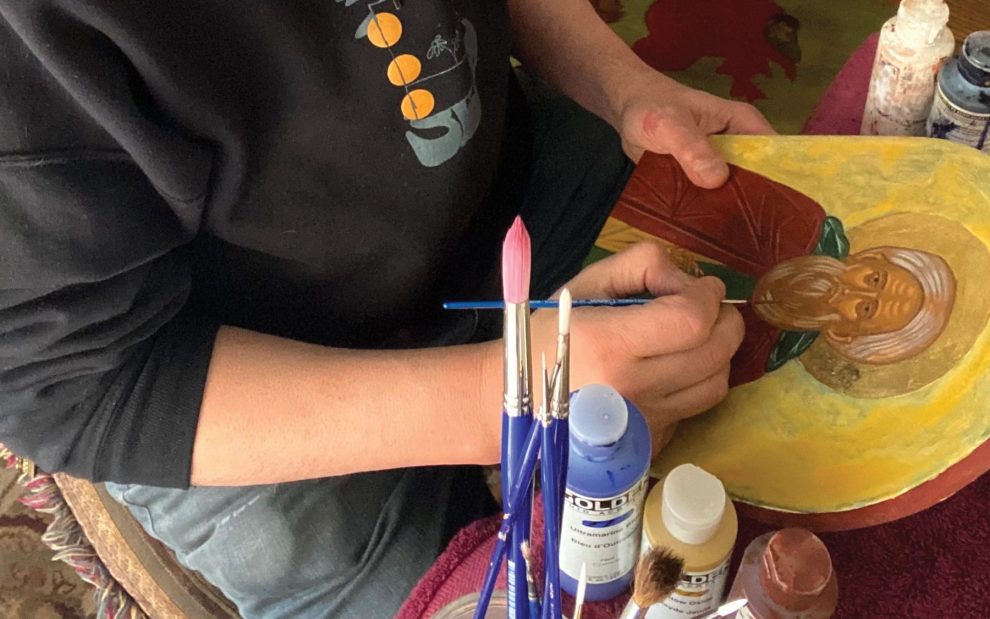Just as I began learning the rudiments of the sacred art of iconography, the man teaching me left for an extended European holiday. He embarked on his vacation, as it were, at the same time I was embarking on my vocation. Nervous about proceeding without his guidance, I asked him how I could make progress if he wasn’t there. Worse, how could I correct any mistakes I made? As he put on his hat and made for the door, his parting words were: “Listen to the icon. It will tell you what to do.”
Now, after many decades of painting icons, I know what my teacher meant. Iconography is not something for me to control and master but rather something that teaches me when I am humble enough to listen.
I too have now passed on this technique and its spirituality to others. As someone who is neither a husband nor a father, teaching others about iconography gives me a generative (as opposed to regenerative) sense of sacred fulfillment. And yet, for me, the greatest joy is not in seeing how deft students are at drawing fine lines, building up chromatic layers, and sculpting forms with paint and brush. No, my greatest joy arises when I see students who have made their white panels smudged with mistakes and corrections—and still have stayed with their icons. When I see them finish with single points of pure white in the eyes, on the forehead, and on the tips of the nose. At such times, I see a mirror of our own journey from darkness to light, from ourselves to God.
Out of the three Abrahamic religions, only Christianity has the privilege of imaging God. Perhaps this is because Christians profess that God took flesh, “pitched a tent,” and physically dwelt among us. While Christians today portray the divine without fear of blasphemy or idolatry, during the first several centuries of the Christian era, they created few sacred images of God, possibly because of the lingering influence of Judaic proscriptions.
At the end of the second century, however, a theology expressed in images emerged throughout the Mediterranean region and far into the deserts of the Middle East. The art found in ancient Mesopotamian house churches and in the Roman catacombs is crudely executed but theologically accurate. It does not merely Christianize pagan gods and ideas but instead expresses a new reality, a new truth. This fresh media was as powerful an expression of divinity as were the writings of its contemporary theologians.
Sacred art emerged from this beginning in two streams, one Eastern and the other Western. From the time of Giotto and Duccio, Western art has constantly evolved as a reflection of Christ’s humanity. Meanwhile, Eastern iconography was dedicated to imaging the eternal and unchanging. Today, nearly the whole of iconography and icon spirituality is rooted in the rich soil of Orthodox Christianity. The journey of creating and praying with icons grows out of the fertile language of Orthodox mysticism.
Some of the uniquely Orthodox terms used to express sacred realities in icons include: Christ as Pantocrator (The All-Powerful); Mary as Theotokos (the Virgin God-Bearer); and Theosis, the divinization of human beings when they share in the very life of God. Iconography also has technical elements, such as inverse perspective, in which objects enlarge as they recede into the background while they are minimized in the foreground, as if to bring the eternal into our temporal realm. Icons also lack exterior light sources in order to show the light of God (the result of Theosis) radiating from within the portrayed figure.
Although the nomenclature of iconography is essentially Orthodox, iconography as a form of prayer and meditation is not exclusive; it can also be applied to Western spirituality. Iconography is rooted in scripture and driven by prayer, which makes its spirituality inclusive and universal (despite some linguistic speedbumps). It embraces traditions and ideas that are common to both Eastern and Western Christianity.
As an iconographer, I see even the materials I use as sacramental. This does not mean I worship the paint, brushes, and panels; rather, I seek to see in them deeper spiritual realities beyond their surface utility. I use wood panels, not merely because wood is durable but also because it honors the cross: At the crucifixion, wood participated in our redemption. In the wider collective consciousness, gold symbolizes wealth and power, but when I use gold in an icon, it signifies humble acknowledgment of God’s eternal and uncreated light. Pigments, traditionally made from rocks and plants, as well as the animal glue that seals the raw panel, all honor the gifts of the animal, vegetable, and mineral worlds.
To Western artistic sensibilities, all this may seem like counterintuitive excess that distracts from the primary business of getting on with the artistic process. Iconography, however, is not an aesthetic endeavor involving the expression of my subjective emotions or circumstances. The purpose, rather, is the quiet manifestation of the incarnation and the fruits of the paschal mystery.
Still, when I paint an icon, I begin with the same challenge any painter, poet, author, composer, or creator of other art forms faces: a blank space. I start with a white panel, gessoed and sanded to glossy perfection. It represents the void I hope to fill with God’s uncreated light.
Like a parent embracing the cherished challenge of a newborn baby, the iconographer lovingly accepts the beautiful and immaculate panel. Entering this process, I know I will inevitably stumble and fall, but nevertheless I commit myself to getting up again, continuing, and, in the end, creating something beautiful for the world. This process is both creation and divinization: creation in that the artist participates in God’s ongoing handiwork, which is a never-ending work of love, divinization in that through artistic work and “listening to the icon,” as my teacher instructed me, God’s life becomes my own. Through this work, I too am transformed.
Soon, underdrawings will cover the once perfectly clean panel. Red clay sits where gold leaf will be drawn, and even then, once the gold leaf is put in place before any other paint, the shining nimbus can easily be scratched, nicked, and spattered with paint. Smudged lines and muddy paint bury the radiance of purity under glutinous layers of mistakes and corrections. And that is merely the beginning of the journey.
What follows is an organic process of expansion and contraction: expansion through the application of ever-lightening layers of pigment and contraction through tightening everything with fine linear strokes. Slowly, a tangible transformation emerges, from formlessness into form, from fragmentation into unification, from darkness into light.
Perhaps the most important stage of the icon-painting journey is the blessing, in which the image is no longer mine but meant for others. Icons, like human beings, are not created as islands, for our own purpose and perfection. They are not intended to be hidden under whatever baskets life throws over us. Instead, they—like us—are meant to be proclamations, imperfect yet still radiant, shining God’s light on all who encounter them.
This article also appears in the March 2024 issue of U.S. Catholic (Vol. 89, No. 3, pages 45-46). Click here to subscribe to the magazine.
Image: Courtesy of Joseph Malham













Add comment